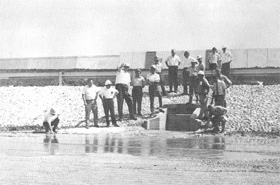First NAL Cooling Pond Becomes Operational
Eventually, many large ponds will exist on the NAL site to provide water for cooling various components of the accelerator and experimental apparatus.
At 10:30 a.m. Monday, July 27, water was turned on for the first time to fill the first of these ponds -- the Central Utility Cooling Pond. It was an informal ceremony with Robert R. Wilson, NAL Director, turning the valve as section leaders and others watched. The purpose was to fill the cooling pond which is primarily for the Booster, the intermediate component in the NAL accelerator system between the Linac and the Main Accelerator.
At first, only a trickle of water appeared in the pond -- but that was the way it was engineered. As time passes, the pond will be constantly filled with water to cool the Booster magnets as they become part of the operational system.
Following is a brief description by Ward Bosworth, NAL Plant Management engineer, on development of the Central Utility Cooling pond:
"The pond provides cooling by exposing a large surface of water to the atmosphere, where for every pound of water evaporated, approximately 250,000 calories of cooling are obtained. These calories leave the pond as the heat or energy that is necessary to change liquid water to water vapor."
"A water spray system has also been installed in this pond to expose additional water surfaces to the air. Further cooling surfaces at the central point have been provided by cooling towers located on the roof of the Central Utility Building. The cooling pond concept has been extended to cool the magnets of the Main Ring in a series of large ponds and a ditch circling the inside of the Ring."
Pond water does not directly come in contact with the magnets. Through heat exchangers the pond water extracts heat from Low Conductivity Water circulating in the magnets (normally referred to as "LCW water"). The LCW water flows in a closed loop pipe system passing successively through the magnets and heat exchangers.
Another use of the pond cooling water is to provide cooling for refrigeration machinery. This refrigeration is used to provide lower temperature LCW water as well as for comfort cooling.




